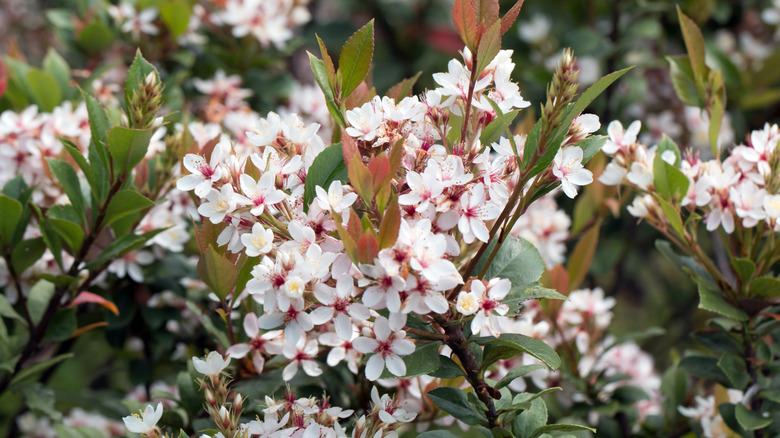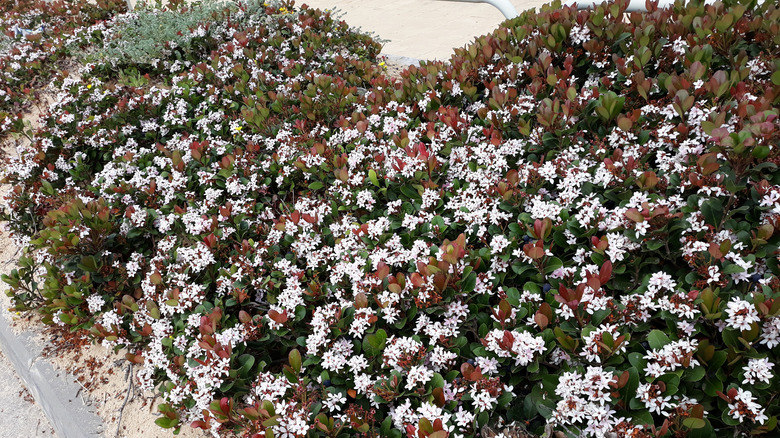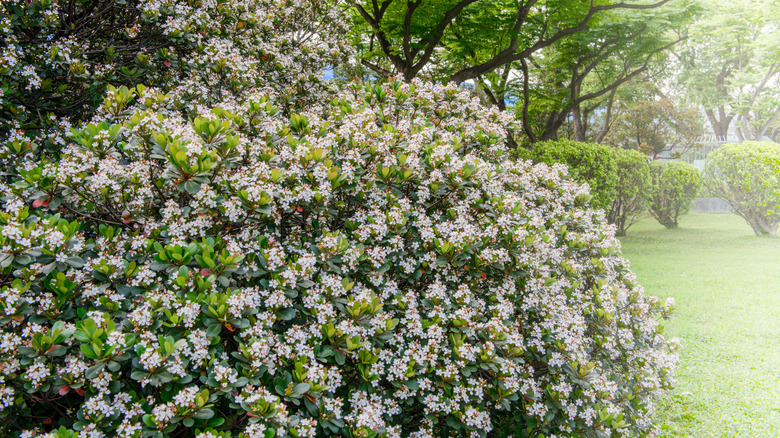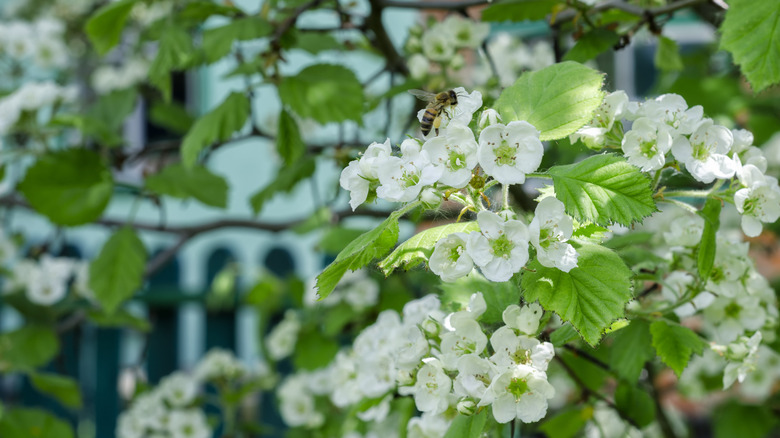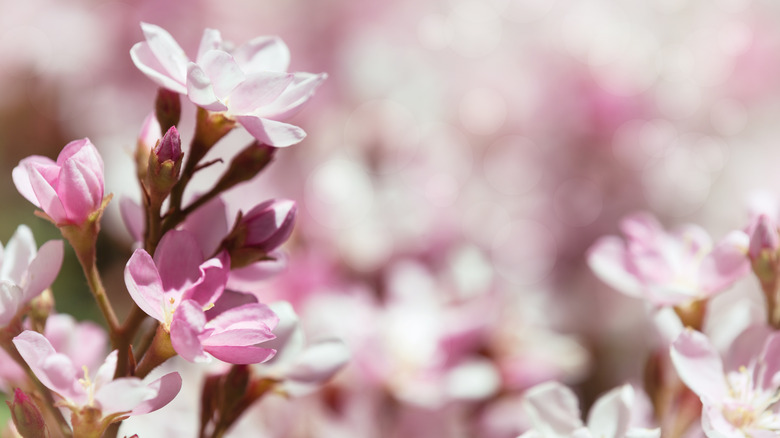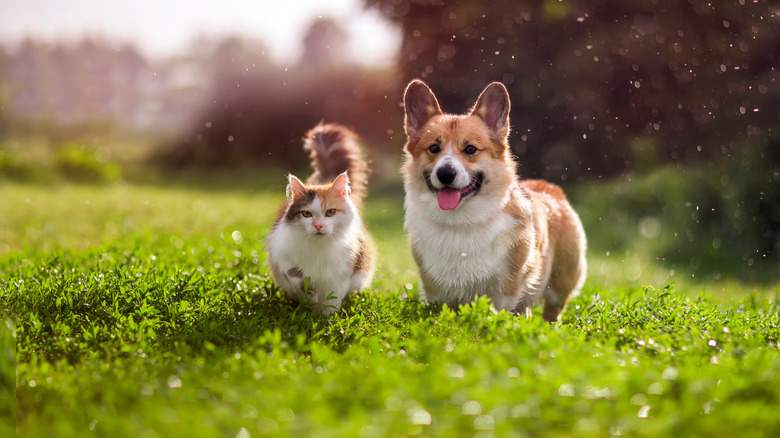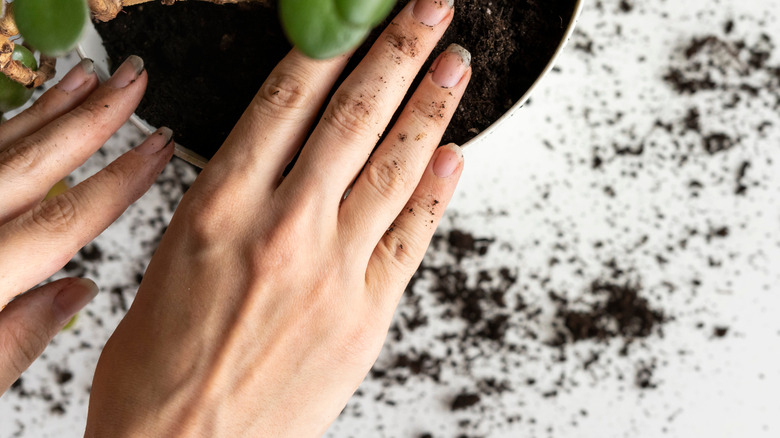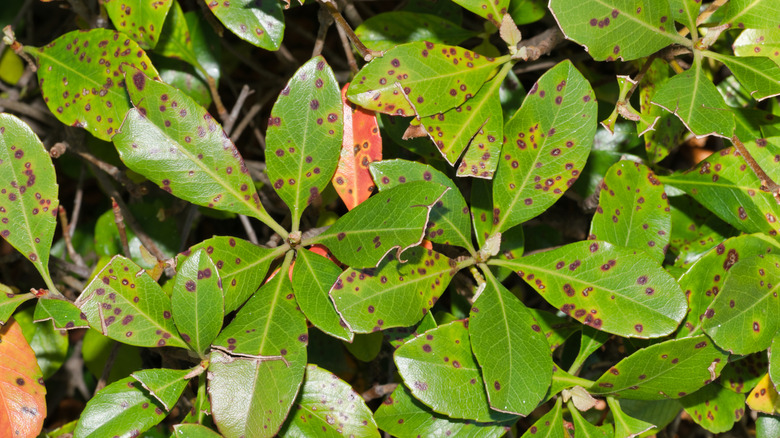Indian Hawthorn: Everything You Should Know Before Planting
Indian hawthorn (scientific name Rhaphiolepis indica) is a popular shrub originally hailing from southern China, as per the Missouri Botanical Garden. It is also commonly found in Asia and Australia, although it can be grown in a variety of climates around the world. This evergreen plant is marked by pink and white blooms in the spring while the rest of the year, it features wide, oval green leaves with a jagged texture around the edges that grow between 2 and 4 inches in length. The shrub itself reaches a height and width of between 4 and 6 feet.
According to The Spruce, caring for an Indian hawthorn plant shouldn't create much fuss as they are pretty self-sufficient when provided with appropriate sunlight, soil, and temperature conditions. The best part is that this shrub is highly resistant to drought and other unfavorable growing conditions once mature, including excessive salt in the soil, making it perfect for coastal locations.
Garden Frontier reports that the Indian hawthorn is especially sought after for its ability to produce edible berries, which continue to sprout from the plant well past the seasonal bloom period of the flowers. If you like to see wildlife in your yard, this feature is particularly attractive to many animal species. Now that you've chosen the Indian hawthorn shrub for your garden, scroll through the following guide for some tips on how to grow and care for this hardy plant.
How to use Indian hawthorn in garden
The possibilities for using Indian hawthorn in your garden are plentiful as this shrub can serve a variety of purposes in any outdoor space. For starters, given the rounded shape of the shrub, it can be a good idea to plant multiple individuals in a row around the exterior of your yard to provide structure and boundaries to the space, especially given the plant's penchant to merge with others of the same species. Clemson Cooperative Extension recommends choosing a design for your Indian hawthorns based on the size of the individual plant. For example, larger shrubs can be planted along a boundary between one property and the next to provide privacy. This same idea also works if your property borders a public sidewalk or passage area. Smaller individuals can serve to delineate garden beds within your yard.
Another popular use of Indian hawthorn in a garden space is to plant individuals in pots or containers. This provides the added advantage of making the plant mobile, allowing you to choose various locations in your yard to place your Indian hawthorn depending on the season, sun movement, etc. Containers are also great for planting Indian hawthorns on a patio or deck, which gives you the opportunity to incorporate their lovely green hue into the color scheme of the space. The main factor in where you plant your Indian hawthorn will be the growing conditions provided by any given location.
How to grow Indian hawthorn
Depending on where you decide to plant your Indian hawthorn in your garden, you will need either a garden bed or planting container to get started. Alternatively, if you've chosen to use a series of Indian hawthorns as a border around a particular area of your property, you will need to use wooden stakes or string to map out the location of the rows. Gather a shovel for digging holes in the soil and a pair of gardening gloves if you'd like to protect your hands while you work.
Before planting the root ball of each Indian hawthorn, Gardening Know How recommends getting rid of weeds and other debris that could get in the way of planting. Each hole you dig should span the length of the root ball without leaving any part of it exposed on top of the soil. The width of each hole should be about two to three times the size of the root ball. Before placing the root ball in the hole, water the soil both in and around the plant's new home. Then, stick the plant in the hole and cover it with soil until it is level with the rest of the ground. Your Indian hawthorns will need additional water after their transplantation and throughout the first several weeks. If you are planting your Indian hawthorn in a container, you will need to purchase well-draining garden soil and follow the same steps as with planting in the ground.
How to care for Indian hawthorn
If you live in a climate with mild winters, within USDA plant hardiness zones 8 through 11, your Indian hawthorn shrubs can survive outdoors all year round. The Spruce points out that it is especially important that Indian hawthorns are grown in a location with full sun to ensure that they thrive in your outdoor space. Ideally, the soil in which you plant your Indian hawthorns will be on the acidic side and provide adequate drainage to avoid water stagnating around the roots of your plants and leaving them susceptible to root rot and other diseases.
The amount of water the Indian hawthorn plant needs depends on the time of year and quantity of rainfall in the area in which it lives. During active growing times, the plant will require additional waterings, while in non-active growing times (typically during the winter), you can feel free to cut back. Keep in mind that Indian hawthorn is resistant to drought once matured, meaning erring on the side of less water will likely be the right choice.
Watters Garden Center recommends that gardeners provide a bit of extra fertilizer during every season except winter to ensure the plant is getting enough nutrition. As a bonus, this low-maintenance shrub shouldn't require any pruning during the growing season, allowing you to sit back and watch it produce fragrant-smelling blossoms with a minimal amount of care.
Varieties of Indian hawthorn
There are many varieties of Indian hawthorn, or Rhaphiolepis indica, to choose from within the Rhaphiolepis species; all of them are evergreen shrubs and grow between 3 and 6 feet in both height and width, although some hybrids can grow up to 12 feet. Rhaphiolepis indica is native to the Asian countries of southern China, Vietnam, Laos, and Japan, and is found growing in the wild on the side of the road, hills, and in coastal locations, according to Natusfera. The differences between the varieties are generally related to color, size, growing conditions, temperature tolerance, and resistance to diseases.
Most Indian hawthorn varieties boast cute names, such as Blueberry Muffin, which features white flowers and stands up to the cold better than its cousin, as per Clemson Cooperative Extension. The Eskimo is another cold-resistant variety, aptly named due to its ability to withstand temperatures as low as 5 degrees Fahrenheit. It is also one of the tallest species, reaching heights of 6 feet. The Indian Princess is smaller than the Indian hawthorn and receives its name from its princess-pink blossoms that change to white later in the growing season. The Snow White variety is another whose name gives away the hue of its blooms; its white flowers contrast nicely with the surrounding vibrant-green leaves. Finally, the Georgia Charm is another great choice, featuring white flowers and an average height of 4 feet.
Is Indian hawthorn toxic?
While the Indian hawthorn plant is not toxic, certain varieties produce berries that can be poisonous if ingested, according to Specialty Produce. Since there are dozens of varieties of this plant, it is important to choose one that is perfectly safe to eat. The good news is that Indian hawthorn berries have been used in medicine and cooking for centuries and it is highly likely that you will be able to eat the berries that your shrubs produce. The most common uses for the berries are in jams and sauces. The abundant presence of antioxidant flavonoids has also made the berries a popular treatment for heart problems over the years.
Given the large variety of Indian hawthorn species that are safe to consume, it shouldn't be hard for you to incorporate a non-toxic variety into your outdoor space if you have young children or pets that tend to eat your plants and flowers. Even if you happen to choose a toxic variety of Indian hawthorn, rest assured that there are steps you can take to minimize or eliminate the risk of harm to your young and/or furry family members. Fencing off areas where your Indian hawthorns grow is a simple way to keep children away from any potentially poisonous berries. Garden Stead offers a couple additional solutions for keeping pets away from toxic plants, including spraying plants with a scent repellant and using clicker or balanced training methods to teach them to ignore the plants.
How to repot Indian hawthorn
Your Indian hawthorn will likely withstand about two to three years of growth before needing an upgrade to a larger pot, according to Wilson Bros Gardens. You will know it is time to repot your shrub when growth diminishes and/or you see roots escaping through the drainage holes of the pot or container. When you purchase a new container, keep in mind that it should allow for an additional 6 inches of growth of the root ball, so take care to choose one with adequate space for your Indian hawthorn to stretch out.
While not necessary for your plant to grow and thrive, filling the base of your new container with a layer of gravel or small stones and then placing a strip of planting fabric over the top will provide a secure barrier between the soil and the drainage holes. You should then layer a bit of soil on top of the fabric. Next, gently pull your Indian hawthorn out of its current pot by holding it towards the base as close to the root ball as possible. If the root ball is stuck, rinse off some of the excess soil with water to break it up. Place your Indian hawthorn in the new container and fill in the excess space with potting soil. You'll know it's good to go when the root ball is completely covered by soil at the top. Don't forget to water abundantly.
Indian hawthorn diseases
Indian hawthorns are susceptible to one fatal disease in particular, known as leaf spot, which is caused by a fungus called Entomosporium mespili, according to Clemson Cooperative Extension. The disease presents as small, reddish-brown dots on the leaves of the shrub that spread across the surface and join together, eventually covering the entire area. As a result, the leaves are killed and fall from the plant. The presence of this fungus on an Indian hawthorn plant is highly infectious, spreading quickly from leaf to leaf and plant to plant. If not treated and/or prevented, leaf spot causes serious injury to affected plants and can even obliterate entire rows of Indian hawthorns.
If your Indian hawthorns are suffering from leaf spot, you'll want to spray the leaves with a fungicide when they first show signs of growth in the spring. It is important to follow up every couple of weeks throughout the rest of the season and into the summer and fall to keep the leaves well coated with the fungicide. Make sure you also clear away infected leaves and dispose of them before the fungus has the opportunity to spread. Preventing the disease is as easy as minimizing waterings and taking care to never leave the soil fully saturated. Indian hawthorn shrubs that grow close together without enough space in between each individual plant also increase the risk of leaf spot by reducing air flow.
